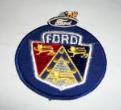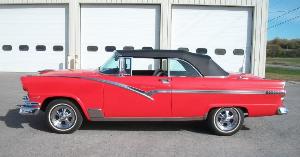|
Author
|
Message
|
|
yblock
|
|
|
Group: Forum Members
Last Active: 11 Years Ago
Posts: 57,
Visits: 189
|
OVERHEATING
have you checked top tank temp versus lower tank.the test needs to be when temp is in the 200 aria. if ther is a large diference say 10 dgrs or more this indicates rad capasity isthe problem pluged or to small,as flow is slow going threw the core. if temp isonly 3-8 dgrs rad is not restricted but aproaching its limit(needs more rows of tubes etc) 210 is not going to hurt any thing with a good cap(12-15psi). damage ocures when water boils.just some lessons we learned in heavey eq world.
|
|
|
|
|
miker
|
|
|
Group: Forum Members
Last Active: Last Month
Posts: 1.9K,
Visits: 194.9K
|
I put A/C on my 55 bird 2 years ago. It has a small pusher fan on the condenser out front, and a electric puller, with a full, well fitted shroud on the radiator. Parked and idling at 90 degrees (which is rare in Seattle), the main fan runs 90-120 seconds, shuts off for 2-3 minutes, and cycles again. This car always had a heating problem, and I'm convinced the custom shroud was the difference. Holds the upper radiator tank at 200 degrees on the infra red thermometer. The lower tank runs about 20 degrees cooler. Aluminum Be Cool radiator.
Before that, I had the factory upper shroud, with the aftermarket lower plastic shroud. I think sealing them against the core would have helped a lot, but I didn't realize that at the time.
I did not see significant differences with Red Lines water wetter, but I run antifreeze. The low tonight is forecast for 15 degrees. Unusual, but it happens.
If you search the site, you'll find a good bit of info, a lot of it by Greenbird56, on water restrictions, shrouds, and fan clutch drives. He's in Tucson, and I was there last June at 107 degrees. So he should know.
miker
55 bird, 32 cabrio F code
Kent, WA
Tucson, AZ
|
|
|
|
|
charliemccraney
|
|
|
Group: Moderators
Last Active: Yesterday
Posts: 6.1K,
Visits: 442.9K
|
yblock (12/7/2013)
OVERHEATING
have you checked top tank temp versus lower tank.the test needs to be when temp is in the 200 aria. if ther is a large diference say 10 dgrs or more this indicates rad capasity isthe problem pluged or to small,as flow is slow going threw the core.I disagree with this. The difference should be quite substantial since the hot coolant enters one end, then passes through the core where it is cooled and then exits the other end. On mine, I don't remember the exact numbers, but the last time I checked, there was nearly a 40 degree difference from the thermostat housing to the water pump inlet. I can actually put my hand on the bottom of the core while it is idling without burning myself. I can touch the top but cannot leave it there. The area within the diameter of the fan is actually not too bad at the top or bottom. My thought is that it is an airflow problem caused by the condenser and the radiator core may need to be larger to have more area for air flow available. Of course, this is assuming everything was in tip top shape before.
Lawrenceville, GA
|
|
|
|
|
oldcarmark
|
|
|
Group: Forum Members
Last Active: 2 days ago
Posts: 3.7K,
Visits: 32.6K
|
I assume you do NOT have the upper air deflector on top of the Rad support?
 
|
|
|
|
|
yblock
|
|
|
Group: Forum Members
Last Active: 11 Years Ago
Posts: 57,
Visits: 189
|
INCORECT,if ther is a big diference it means the water is moveing slowly threw the rad,due to restriction,or to small a rad size,when the thermo opens the water pump will cavitate makeing things bad.when the thermostat is closed of corce the uper and lower tanks will balance out.but when temp is such that the thermo is open the top and lower tanks should not varry that much. also hot watter rejects heat better than cold. THe fact that toptank is so hot you cant leave your hand ther,and the botem is cold tels you the therm is open but not enough water is flowing threw the cores. now waterpump will start to cavitate as it cant gat enough water flow for its size, now engine will overheat,temp gauge will not be corect. head tempgoes threw the roof.
go to the internet andlook up engine cooling desighn. not trying to be a wiseas but wenthrew this in several repowers with of highway log trucks. it is ahard sell but cured the coolin in extreem temps
|
|
|
|
|
charliemccraney
|
|
|
Group: Moderators
Last Active: Yesterday
Posts: 6.1K,
Visits: 442.9K
|
I don't find anything with a brief search. Got any links? So you are saying that the radiator should not cool the coolant more than 10 degrees? If it does, then it has a restriction or it is too small? This doesn't make sense The coolant increases in temperature by about 20 degrees just by going across the top of the head, from the temperature sender to the thermostat housing. That's not taking into account the increase between the water pump and past all of the cylinders. So if the radiator removes no more than 10 degrees, then the net temperature increases by more than 10 degrees per pass of the coolant. That will lead to overheating. I experience no overheating with my 40 or so degrees between the input and output of the radiator.
Lawrenceville, GA
|
|
|
|
|
The Master Cylinder
|
|
|
Group: Forum Members
Last Active: 4 Years Ago
Posts: 974,
Visits: 6.2K
|
YBlock, I found it interesting what you were saying so to understand better I looked it up and found some more info. This is from just one site I found that explained it to me in language I could understand (Haha, I'm definitely not a thermal engineer). Thanks for the learning experience. Heat Load to the Cooling System. The heat load to the cooling system is related to the flow through the radiator and the temperature drop through the radiator by the following expression: Q = M * cp *dT Where Q is the heat load BTU/min., M is the mass flow rate of the coolant in BTU per pound per degree F, dT is the temperature drop through the radiator in degrees F, and * indicates multiplication. Since a gallon of coolant weighs about 8.3 pounds, we can replace M in the expression by 8.3 times the coolant flow in gallons per minute, or GPM. The resulting expression is as follows: Q = 8.3 * GPM * cp * dT Since the specific heat of the coolant is essentially constant and the coolant flow rate is constant at rated engine speed, the expression tells us something that surprises most people. That is, for a given heat load and coolant flow rate, the coolant temperature drop through the radiator will be constant, and nothing anyone can do to the design of the radiator can change that. Adding rows or fins or face area or whatever will not change the temperature drop through the radiator. As a general rule, cooling systems are designed to operate with a coolant temperature of about 190 degrees F at the radiator inlet and have about a 10 degree F temperature drop through the radiator at rated power and rated coolant flow. This will result in a bottom tank temperature of 180 degrees F. Here's a link to that site; http://www.arrowheadradiator.com/14_rules_for_improving_engine_cooling_system_capability_in_high-performance_automobiles.htm
 "The Master Cylinder" "The Master Cylinder"
Enjoying life at the beach in SOCAL 
|
|
|
|
|
charliemccraney
|
|
|
Group: Moderators
Last Active: Yesterday
Posts: 6.1K,
Visits: 442.9K
|
Thanks for that. That just confuses me further. In the beginning it says nothing you can do will change it but then farther down it says you can change these things which may or may not improve it. And according to this info, my engine should be quite severely overheating but it is not. There has to be more to it. I guess I'm glad I'm not the one with a cooling problem right now  Did you see what cp means in that formula? I didn't find that.
Lawrenceville, GA
|
|
|
|
|
Daniel Jessup
|
|
|
Group: Forum Members
Last Active: 2 hours ago
Posts: 2.0K,
Visits: 131.0K
|
Interesting read on that article from Arrow. What confuses people is that they have a list of "improvement rules" as you scroll down the page, and then at the very bottom it says that Copper is a better conductor of heat, or heat transfer, than aluminum. All of these changes to an otherwise stock system would affect the overall rate of lowering the coolant's temperature as you run your engine. Otherwise, the folks who put out this information would not have listed it as such. I personally know the real world difference between a 4 row and a 2 row 56 Ford radiator. OVERALL the lowering of the coolant temp/engine temp was drastic enough that I had to put a much higher thermostat in it even in the summer. Driving it in the winter and very cold temperatures almost made the coolant temp reach 170 at cruise. The heater core barely had warm air in the plenum. When I let the car idle, it would come back up to 190 and of course hot air through plenum. I actually had to put a piece of cardboard in front of the half of the radiator because it was cooling so well at cruise.
Daniel JessupLancaster, California aka "The Hot Rod Reverend" 
check out the 1955 Ford Fairlane build at www.hotrodreverend.com
|
|
|
|
|
yblock
|
|
|
Group: Forum Members
Last Active: 11 Years Ago
Posts: 57,
Visits: 189
|
MY post is when you have a over heating condition. ,IF you have a 40dgr. diference top to botm tank and no over heating that is great,you dont have a isue. .Tho that indicates you have a system that is capable of cooling much more.
unless i misunderstood ,original post was running hot. some posts advised larger watepump,decrease bypasssize.thes will not help if rad is to small or restricted. reducing bypass will create cavitation, Cavitation is a killer as tempguage will not register acuratley,resulting in headgasket failure and cracked cylender heads.
|
|
|
|